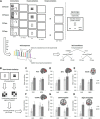Pattern Analyses Reveal Separate Experience-Based Fear Memories in the Human Right Amygdala
- PMID: 28733358
- PMCID: PMC6596782
- DOI: 10.1523/JNEUROSCI.0908-17.2017
Pattern Analyses Reveal Separate Experience-Based Fear Memories in the Human Right Amygdala
Abstract
Learning fear via the experience of contingencies between a conditioned stimulus (CS) and an aversive unconditioned stimulus (US) is often assumed to be fundamentally different from learning fear via instructions. An open question is whether fear-related brain areas respond differently to experienced CS-US contingencies than to merely instructed CS-US contingencies. Here, we contrasted two experimental conditions where subjects were instructed to expect the same CS-US contingencies while only one condition was characterized by prior experience with the CS-US contingency. Using multivoxel pattern analysis of fMRI data, we found CS-related neural activation patterns in the right amygdala (but not in other fear-related regions) that dissociated between whether a CS-US contingency had been instructed and experienced versus merely instructed. A second experiment further corroborated this finding by showing a category-independent neural response to instructed and experienced, but not merely instructed, CS presentations in the human right amygdala. Together, these findings are in line with previous studies showing that verbal fear instructions have a strong impact on both brain and behavior. However, even in the face of fear instructions, the human right amygdala still shows a separable neural pattern response to experience-based fear contingencies.SIGNIFICANCE STATEMENT In our study, we addressed a fundamental problem of the science of human fear learning and memory, namely whether fear learning via experience in humans relies on a neural pathway that can be separated from fear learning via verbal information. Using two new procedures and recent advances in the analysis of brain imaging data, we localized purely experience-based fear processing and memory in the right amygdala, thereby making a direct link between human and animal research.
Keywords: amygdala; fear; instructions; learning.
Copyright © 2017 the authors 0270-6474/17/378116-15$15.00/0.
Figures








References
MeSH terms
LinkOut - more resources
Full Text Sources
Other Literature Sources
Medical
